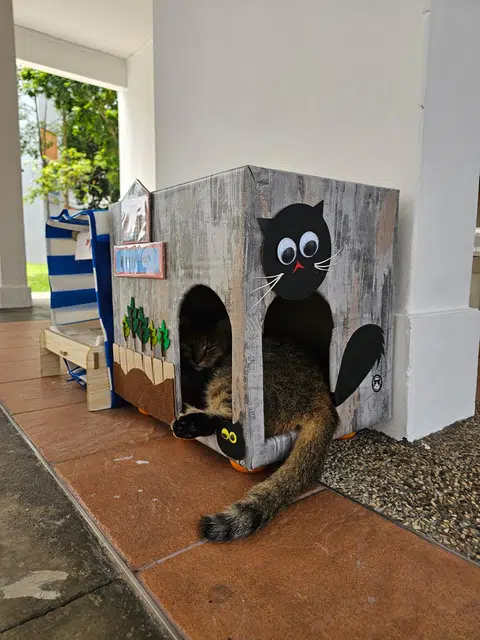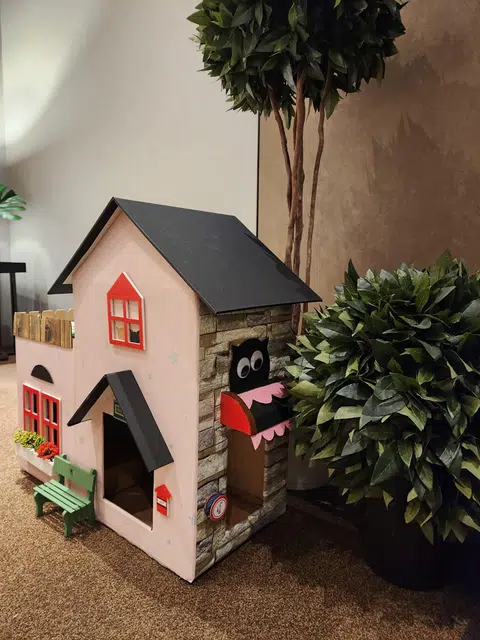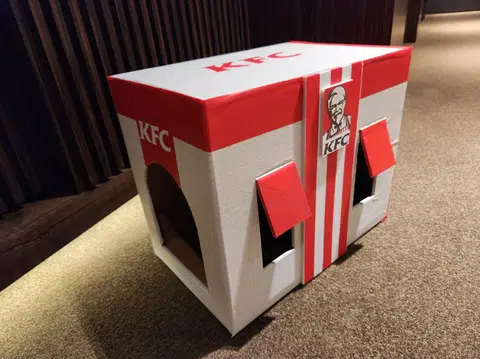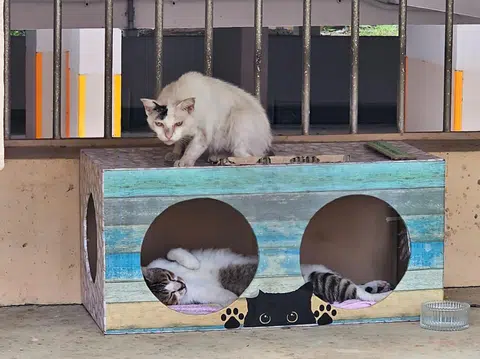Stylish cat 'cottages' a labour of love for Chong Pang resident
Whenever heavy rains lash across the island, a handful of stray cats in Yishun are able to stay warm, cosy and safe from the deluge. But you won't find them in somebody's home at such times. Instead, they can be found in charming, handcrafted shelters with sturdy legs, dotted around parts of the estate.
The shelters or "cat cottages" are the handiwork of Chong Pang resident Janet Chin, 54.
For the last three years, she has been blending her love for animals with arts and crafts, by transforming scrapped cardboard boxes into whimsical homes.
The idea, she said, came to her one rainy day, when she began thinking about how stray cats that lacked proper shelter often sought refuge in precarious locations - under parked cars and other such spots - to escape the elements.
"That was when I started to think of doing a cat house."
The first ones she made were crafted out of plain cardboard boxes covered with a dry towel - a set-up that, she admits, was "ugly".

She then set out to "beautify" the make-shift cottages, beginning with the addition of water-resistant wallpaper, taken from her personal stash of crafting materials - leftovers from a home decor project for her living room.
She sources for leftover cardboard from grocers or supermarkets, or opts for recycled materials, including the plastic containers used for cat treats.
Eventually, she cut out windows in the boxes and added planters and other fixtures like chimneys - a cottage in miniature.

"It became a little addictive. The more I made, the more fulfilling it felt," said Ms Chin, a sales consultant in the bedding industry.
Soon, her hobby started eating into her lunch breaks and days off work. In three years, she has built close to 100 cat cottages, she said.
Whether embellished with cut-outs or framed by cobblestone walls, each shelter has its own distinct character, sometimes decorated to reflect the spirit of seasonal festivities.
For instance, a cottage could be festooned with snowflakes and cutouts of a Christmas tree during the holiday season, or adorned with spring festival couplets and Chinese knots for Lunar New Year celebrations.

Eventually, Ms Chin began putting up photos of her cottages on the Facebook group Sayang Our Singapore's Community Cats.
One such post drew over 200 reactions, with netizens thanking her for her "lovely gestures" and "kindness".
She then started getting requests from cat lovers keen on helping stray cats get their own shelters, marking her foray into the cat cottage "build-to-order" market.
Often, the requests are for replicas of cottages she has built before.
"I want the KFC house," one cat lover said to Ms Chin. The KFC house, modelled after a popular chain selling fried chicken, is part of a series of cat cottages she built that are modelled after fast-food eateries.
Her most recent request came from a resident in Braddell, who wanted six houses.

Caregivers reminded to maintain hygiene standards
When asked if she gets paid for her work, she said she does not charge for her work but sometimes asks for a small donation.
Ms Chin said what she is doing is not a commercial venture.
Donations she gets are used to cover veterinary and cremation fees for neighbourhood strays. Often, the people who cough up money for these expenses are seniors in the neighbourhood - cat lovers who also help feed the strays.
All that she asks is that the people who buy a cat cottage take responsibility for maintaining the shelters they leave out for the cats.
She said: "I don't want people to just ask for one cat house and leave it there. They are not the caregivers for the cats, so they just leave the cat house along the public spaces without maintaining its cleanliness."
In response to queries, Ms Li Jiehui, senior community engagement manager at the Cat Welfare Society, said that while the shelters "are a welcome respite for some of our community cats", residents should also "display (their) care in a responsible fashion".
These shelters should be placed away from human traffic areas and hygiene standards should be maintained, she said.
Ms Chin said she takes pride in designing cat cottages designed to suit the occupant's personalities and needs.
Sociable felines may receive larger homes - up to 1m long - to accommodate room-mates, while more reserved ones get smaller, cosier versions.

Each shelter is equipped with at least two access points, allowing the cats to flee if the need arises.
Perhaps the most thoughtful touch - fresh, dry towels, which Ms Chin replaces when she gets the time.
Ms Chin, who is married with no children, said she believes the homes add colour and vibrancy to the neighbourhood.
They are also help spark conversations among residents, and help them see stray cats in a more positive light, she added.
Said Ms Chin: "They are a part of our community, they have a house, they have a caregiver. They are taken care of. They are not simply dirty cats."
Calista Wong for The Straits Times